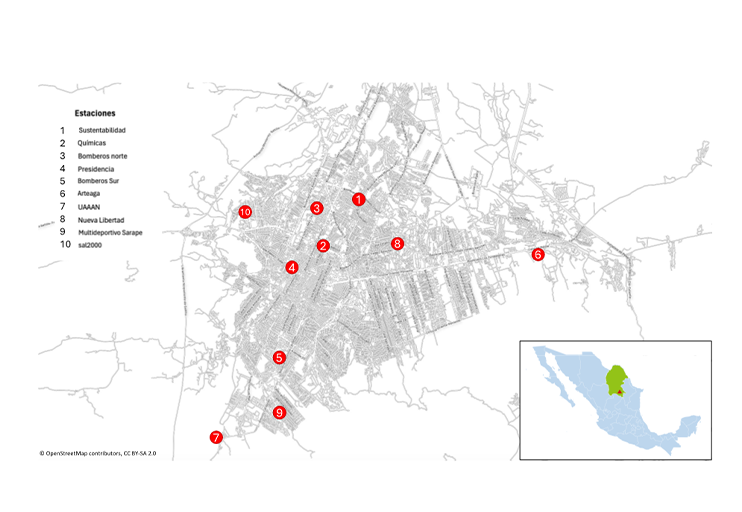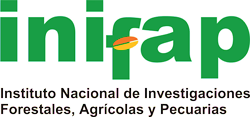Influencia de variables meteorológicas en la concentración de PM2.5 en Saltillo, Coahuila
DOI:
https://doi.org/10.29312/remexca.v16i30.4045Palabras clave:
calidad del aire, contaminación, capa límite, material particuladoResumen
En el presente trabajo se estudió la relación de las condiciones meteorológicas con la concentración de material particulado, de diámetro igual o menor a 2.5 µm (PM2.5) en la ciudad de Saltillo, Coahuila, con el objetivo de identificar las zonas y horarios con mayores niveles de contaminación. Se recopilaron datos de temperatura, velocidad del viento, humedad relativa, radiación solar y presión atmosférica, así como la concentración diaria de partículas PM2.5 a través de una red de diez sensores de monitoreo de calidad del aire y dos observatorios atmosféricos, distribuidos por toda la ciudad, durante 2024. Primero se analizaron los datos de la red de sensores, encontrando que el coeficiente Pearson mostró una correlación alta o moderada entre la concentración registrada por los sensores, sin importar ubicación, siendo la Zona Oeste la que presentó más días con baja calidad del aire. Posteriormente se analizaron los datos de los observatorios con la finalidad de relacionar las condiciones meteorológicas con las concentraciones de PM2.5 en promedio diario y según el comportamiento de los PM2.5 por hora, se encontró que los factores meteorológicos no presentan una relación significativa con la concentración de PM2.5, cuando se comparan con el promedio diario; sin embargo, cuando se observó la concentración a lo largo del día, se localizó la relación con los parámetros atmosféricos.
Descargas
Citas
Akinwumiju, A. S.; Ajisafe, T. and Adelodun, A. A. 2021. Airborne particulate matter pollution in Akure metro city, Southwestern Nigeria, West Africa: attribution and meteorological influence. Journal of Geovisualization and Spatial Analysis. 5(1):01–17. https://doi.org/10.1007/s41651-021-00079-6.
Akpinar, S.; Oztop, H. F. and Akpinar, E. K. 2008. Evaluation of relationship between meteorological parameters and air pollutant concentrations during winter season in Elaziǧ, Turkey. Environmental Monitoring and Assessment. 146(1-3):211-224. https://doi.org/10.1007/s10661-007-0073-9.
Al Jallad, F. A.; Al Katheeri, E. A. and Al Omar, M. A. 2013. Concentrations of particulate matter and their relationships with meteorological variables. Sustainable Environment Research. 23(3):191-198.
Whiteman, C. D. 1982. Breakup of temperature inversions in deep mountain valleys: Part I. Observations. Journal of Applied Meteorology and Climatology, 21(3):270-289.
Galindo, N.; Varea, M.; Gil-Moltó, J.; Yubero, E. and Nicolás, J. 2011. The influence of meteorology on particulate matter concentrations at an urban mediterranean location. Water, Air and Soil Pollution. 215(1-4):365-372. https://doi.org/10.1007/s11270-010-0484-z.
Hama, S. M. L.; Kumar, P.; Harrison, R. M.; Bloss, W. J.; Khare, M.; Mishra, S.; Namdeo, A.; Sokhi, R.; Goodman, P. and Sharma, C. 2020. Four-year assessment of ambient particulate matter and trace gases in the Delhi-NCR region of India. Sustainable Cities and Society. 54:102003. https://doi.org/10.1016/j.scs.2019.102003.
Islam, Md. R.; Jayarathne, T.; Simpson, I. J.; Werden, B.; Maben, J.; Gilbert, A.; Praveen, P. S.; Adhikari, S.; Panday, A. K.; Rupakheti, M.; Blake, D. R.; Yokelson, R. J.; Decarlo, P. F.; Keene, W. C. and Stone, E. A. 2020. Ambient air quality in the Kathmandu Valley, Nepal, during the pre-monsoon: concentrations and sources of particulate matter and trace gases. Atmospheric Chemistry and Physics. 20(5):2927-2951. https://doi.org/10.5194/acp-20-2927-2020.
Kartal, S. and Özer, U. 1998. Determination and parameterization of some air pollutants as a function of meteorological parameters in Kayseri, Turkey. Journal of the Air and Waste Management Association. 48(9):853-859. https://doi.org/10.1080/10473289.1998.10463738.
Marsh, K. J. and Foster, M. D. 1967. An experimental study of the dispersion of emissions from chimneys in Reading-I: The study of long-term average concentrations of sulphur dioxide. Atmospheric Environment. 1(5):527-550.
Mendoza, H. J. M. 2017. Diagnóstico climático para la zona de influencia inmediata de la UAAAN. Boletín Agrometeorológico. 99-100 pp.
Oguz, E.; Kaya, M. D. and Nuhoglu, Y. 2003. Interaction between air pollution and meteorological parameters in Erzurum, Turkey. In Int. J. Environment and pollution. 19(3):292-300.
Savov, P. B.; Skakalova, T. S.; Kolev, I. N. and Ludwig, F. L. 2000. Lidar investigation of the temporal and spatial distribution of atmospheric aerosols in mountain valleys. Journal of Applied Meteorology. 41(5):528-541. https://doi.org/10.1175/1520-0450(2002)041<0528:LIOTTA>2.0.CO;2.
Tai, A. P. K.; Mickley, L. J. and Jacob, D. J. 2010. Correlations between fine particulate matter (PM2.5) and meteorological variables in the United States: implications for the sensitivity of PM2.5 to climate change. Atmospheric Environment. 44(32):3976-3984. https://doi.org/https://doi.org/10.1016/j.atmosenv.2010.06.060.
Mendoza, U. I. y Vázquez, Z. M. A. 2017. Detección de extremos climáticos de precipitación y temperatura en el estado de Guerrero. 21(1):13-30.
West, J. J.; Cohen, A.; Dentener, F.; Brunekreef, B.; Zhu, T.; Armstrong, B.; Bell, M. L.; Brauer, M.; Carmichael, G.; Costa, D. L.; Dockery, D. W.; Kleeman, M.; Krzyzanowski, M.; Künzli, N.; Liousse, C.; Lung, S. C. C.; Martin, R. V.; Pöschl, U.; Pope, C. A. and Wiedinmyer, C. 2016. What we breathe impacts our health: improving understanding of the link between air pollution and health. Environmental Science and Technology. 50(10):4895-4904. https://doi.org/10.1021/acs.est.5b03827.
Xu, Y; Xue, W.; Lei, Y.; Huang, Q.; Zhao, Y.; Cheng, S.; Ren, Z. and Wang, J. 2020. Spatiotemporal variation in the impact of meteorological conditions on PM2.5 pollution in China from 2000 to 2017. Atmospheric Environment. 223:117215. https://doi.org/https://doi.org/10.1016/j.atmosenv.2019.117215.
Xu, J.; Yan, F.; Xie, Y.; Wang, F.; Wu, J. and Fu, Q. 2015. Impact of meteorological conditions on a nine-day particulate matter pollution event observed in December 2013 shanghai, China. Particuology. 20:69-79. https://doi.org/10.1016/j.partic.2014.09.001.
Yadav, S.; Praveen, O. D. and Satsangi, P. G. 2015. The effect of climate and meteorological changes on particulate matter in Pune, India. Environmental Monitoring and Assessment. 187(7):402. https://doi.org/10.1007/s10661-015-4634-z.
Yangyang, X.; Bin, Z.; Lin, Z. and Rong, L. 2015. Spatiotemporal variations of PM2.5 and PM10 concentrations between 31 Chinese cities and their relationships with SO2, NO2, CO and O3. Particuology. 20:141-149. https://doi.org/10.1016/j.partic.2015.01.003.
Zender-Świercz, E.; Galiszewska, B.; Telejko, M. and Starzomska, M. 2024. The effect of temperature and humidity of air on the concentration of particulate matter - PM2.5 and PM10. Atmospheric Research. 312:107733. https://doi.org/10.1016/j.atmosres.2024.107733.
Zhao, S.; Yu, Y.; Yin, D.; He, J.; Liu, N.; Qu, J. and Xiao, J. 2016. Annual and diurnal variations of gaseous and particulate pollutants in 31 provincial capital cities based on in situ air quality monitoring data from China national environmental monitoring center. Environment International. 82:92-106. https://doi.org/10.1016/j.envint.2015.11.003.

Descargas
Publicado
Cómo citar
Número
Sección
Licencia
Derechos de autor 2025 Revista Mexicana de Ciencias Agrícolas

Esta obra está bajo una licencia internacional Creative Commons Atribución-NoComercial 4.0.
Los autores(as) que publiquen en Revista Mexicana de Ciencias Agrícolas aceptan las siguientes condiciones:
De acuerdo con la legislación de derechos de autor, Revista Mexicana de Ciencias Agrícolas reconoce y respeta el derecho moral de los autores(as), así como la titularidad del derecho patrimonial, el cual será cedido a la revista para su difusión en acceso abierto.
Los autores(as) deben de pagar una cuota por recepción de artículos antes de pasar por dictamen editorial. En caso de que la colaboración sea aceptada, el autor debe de parar la traducción de su texto al inglés.
Todos los textos publicados por Revista Mexicana de Ciencias Agrícolas -sin excepción- se distribuyen amparados bajo la licencia Creative Commons 4.0 atribución-no comercial (CC BY-NC 4.0 internacional), que permite a terceros utilizar lo publicado siempre que mencionen la autoría del trabajo y a la primera publicación en esta revista.
Los autores/as pueden realizar otros acuerdos contractuales independientes y adicionales para la distribución no exclusiva de la versión del artículo publicado en Revista Mexicana de Ciencias Agrícolas (por ejemplo incluirlo en un repositorio institucional o darlo a conocer en otros medios en papel o electrónicos) siempre que indique clara y explícitamente que el trabajo se publicó por primera vez en Revista Mexicana de Ciencias Agrícolas.
Para todo lo anterior, los autores(as) deben remitir el formato de carta-cesión de la propiedad de los derechos de la primera publicación debidamente requisitado y firmado por los autores(as). Este formato debe ser remitido en archivo PDF al correo: revista_atm@yahoo.com.mx; revistaagricola@inifap.gob.mx.
Esta obra está bajo una licencia de Creative Commons Reconocimiento-No Comercial 4.0 Internacional.


